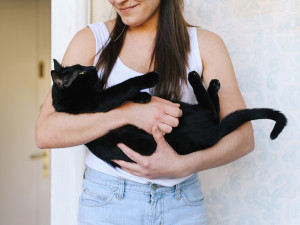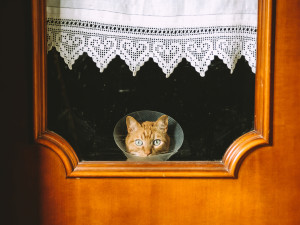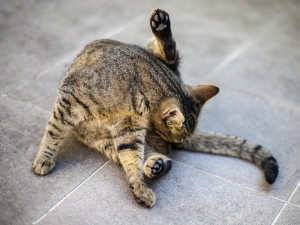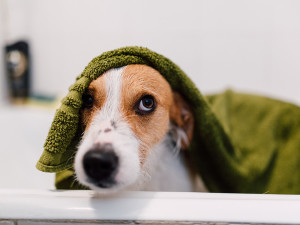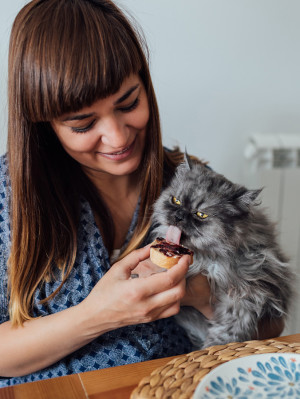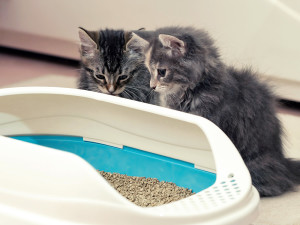Understanding Cat Anal Glands and Cat Anal Gland Discharge
We cover everything you need to know.
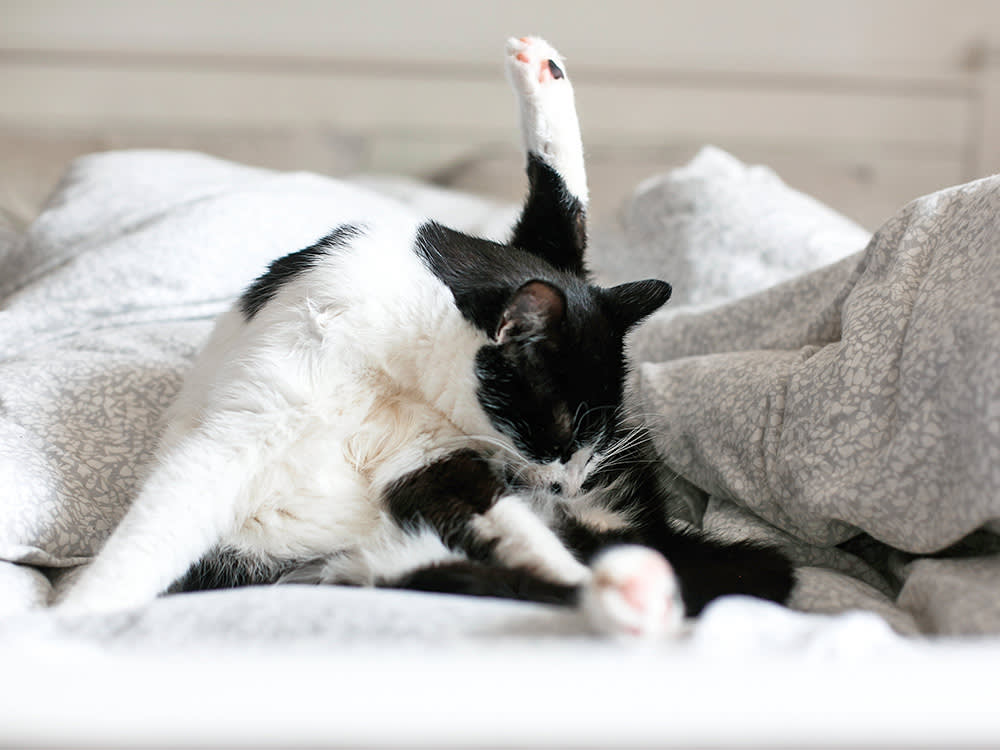
Share Article
In This Article:
Understanding Cat Anal Glandsopens in a new tab When to See a Veterinarian for Cat Anal Gland Problemsopens in a new tab Regular Grooming and Hygiene to Help Prevent Anal Diseasesopens in a new tab Frequently Asked Questionsopens in a new tab
Many people associate anal glands and anal gland problems with dogs, so it may surprise you to learn that cats also have anal glands. They are located on either side of the anus and produce a pungent secretion which plays a role in communication and territorial marking. You may not have heard about them because they usually do not cause problems in cats. However, some cats may experience impaction, infection, or abscesses, causing great discomfort. Understanding the basics of anal gland health can help cat parents recognize when intervention or veterinary care might be necessary.
Main Takeaways
Cats have anal glands but rarely have problems with them.
The contents of anal glands are normally expressed during defecation.
The normal secretions from anal glands are thin and clear or pale.
There are many different causes of anal gland problems in cats.
Signs to watch for include scooting, swelling, biting, and discharge.

littleKin™ is Kinship’s home just for puppy and kitten parents. Bop over to check out expert advice, new pet tools, and special deals—all curated for your newest family member.
opens in a new tabUnderstanding cat anal glands
Anal glands in cats evolved as a method of scent communication among wild and ancestral cats. The secretions from these glands played an important part in marking territory and relaying information to other cats, such as identification or reproductive status. Modern domestic cats still have these glands, even though they are really not needed. Problems with the glands are rare but can happen in impaction, infection, and abscesses.
What are anal glands?
Anal glands in cats are two small sacs located just inside the rectum at the four and eight o’clock positions. They are not usually visible, but sometimes, you can see the duct openings that lead to them. The purpose of anal glands is to store and secrete a scent-marking fluid. This fluid used to play an important role in ancestral felines, aiding communication and territory marking. This role has disappeared in modern-day cats as they have become domesticated.
How do anal glands function?
A cat’s anal glands normally secrete a strong-smelling fluid. Normal fluid is thin, clear, or pale and is usually expressed during defecation or when a cat is frightened or stressed. If the anal glands do not empty correctly, it can lead to impaction, infection, or abscesses, which are very uncomfortable for a cat.
Normal discharge vs. abnormal discharge
Cat anal gland discharge can vary in color and consistency. Normal anal gland discharge in cats can be a clear, thin fluid to slightly yellowish. It can even be a bit thickened and pale brown. People often describe the odor as “fishy.” The smell is usually not detected except during stress, such as grooming.
However, when you see the abnormal fluid secreted when the glands are impacted or infected, it is thick, pasty, brown, or even blood-tinged opens in a new taband particularly foul-smelling. If this change in secretions occurs and you see scooting, excessive licking or chewing around the tail base, discomfort upon defecation, or visible swelling or redness near the anus, it is time to be concerned.
Common causes of anal gland issues
There are a variety of causes of anal gland issues in cats. These include:
Impaction or blockage. This can occur when the anal glands are not properly emptied during defecation.
Infection or abscess formation can occur from bacteria getting into the glands from the intestinal tract.
Dietary factors or obesity may require weight loss and added fiber to avoid an increase in the pressure on the anal region, which hinders normal sac expression.
Trauma to the anal area can disrupt the normal function of a cat’s anal glands.
There are other causes, such as cancer of the anal glands or surrounding region, but that is very rare.
Breeds of cats more prone to anal gland problems
Certain cat breeds may be more prone to anal gland problems due to their genetic predispositions or unique physical traits:
Persian Cats, with their long, dense fur, can have chronic hygiene issues around the anal area, which can lead to impactions or infections. They are also prone to obesity, which can lead to more difficulty reaching certain areas for grooming.
Himalayan Cats also have long fur and the potential for obesity. Due to poor grooming habits, they are more likely to develop inflammation in the area.
Exotic Shorthairs are a close relative of Persian Cats and may inherit similar risks due to their body shape and proclivity for weight gain.
Any cat prone to obesity is at higher risk for anal gland issues due to reduced activity, pressure on the anal area, and less effective self-grooming. In addition, cats prone to soft stools or diarrhea are more at risk for anal gland problems due to less pressure on the anal glands to naturally empty them. An example is Siamese cats, who may have food allergies or sensitivities.
Signs to watch for anal gland issues
Cats often hide signs of illness. However, if they have anal gland problems, they are likely to let you know with one or more of the following actions:
Scooting or dragging the rear end
Excessive licking or biting at the anal area
Visible swelling or redness near the anus
Foul-smelling discharge
Some cats may cry when touched near the rear end or avoid the litter box. If the anal gland problem is severe, you may see swelling, redness, or abscesses around the anal glands. If you see any of these symptoms, have your cat immediately examined by your veterinarian.
When to see a veterinarian for cat anal gland problems
A veterinarian should see your cat if you observe any of the above symptoms. If the signs are mild but persistent or worsen, it’s time to make that appointment promptly. As mentioned, cats are quick to hide their health problems. That’s one reason why it’s important to schedule regular vet visits. A good physical exam can detect problems your cat isn’t showing you. Also, seeing the vet even when signs are subtle is always a good idea because early diagnosis of any medical issue is more likely to lead to a positive outcome. You can avoid more serious complications if you start treatment early.
Diagnostic methods for anal gland problems
If you suspect your cat is having an anal gland problem, the first step is a visit to your veterinarian. Your cat’s history (symptoms and behavior at home) will be essential information for your vet. That and a thorough physical exam is often all that is needed to assess the anal glands. The physical exam will include a manual examination for swelling, impaction, or abscess formation. Most often, the vet will perform a rectal exam to determine the severity of the issue.
If an infection or an abscess is suspected, the veterinarian will collect a sample of the gland’s contents for culture and sensitivity to help determine the appropriate antibiotic. In rare cases, your vet may want X-rays or ultrasound to look for tumors or deeper abscesses. In addition, they may also recommend blood tests to look for underlying health conditions that may be contributing to the problem or check for systemic infection. Again, early diagnosis is key to successful treatment.
Treatment options for anal gland issues
Depending on the diagnosis, treatment may include home care, veterinary treatments, natural remedies, supplements, or a change in diet and nutrition. In some cases, your vet may advise multiple therapies.
Home care for mild symptoms
For mild anal gland issues in cats, home care can help provide relief, but a veterinarian should guide you. Warm compresses can reduce swelling and discomfort. Adding canned pumpkin or a veterinarian-recommended fiber supplement can encourage healthy bowel movements, which will naturally express the anal glands. Fresh water or wet food can encourage proper hydration to support digestive health.
Monitor your cat closely for signs of worsening symptoms. Avoid expressing the glandsopens in a new tab unless adequately trained, as improper handling can cause injury or infection.
Veterinary treatments
The severity of the problem determines whether the treatment will be simple home care or veterinary care.
If impacted anal glands are diagnosed, the treatment may be as simple as manually expressing the contents of the impacted anal glands. Your vet can do this in an awake cat unless they are particularly aggressive or painful. In those cases, they may administer a sedative or pain relief. They may also recommend a recheck to ensure the anal glands are functioning normally and the problem is not chronic. Your vet might recommend dietary changes, including more fiber in the diet and weight management. Warm compresses may also be advised to decrease swelling.
If infection is suspected, treatment will either be antibiotics, with a culture and sensitivity possibly sent to the laboratory to ensure the correct antibiotic choice. Your vet may also prescribe an anti-inflammatory medication and a pain medication.
Only in severe cases that do not respond to treatment will surgery to remove the anal glands be discussed. The surgery is complicated, may need to be done by a surgical specialist, and can have post-op difficulties.
In most cases of anal gland problems in cats, surgery is not necessary. Manual treatment, plus medication and dietary changes, are usually sufficient.
Natural remedies and supplements
Natural remedies and supplements can help cats with chronic anal gland problems, but they should be at the advice of your veterinarian.
Adding fiber to the diet, such as canned pumpkin, psyllium husk, or flaxseed, can promote regular bowel movements.
Omega-3 fatty acid supplements may reduce inflammation and help maintain healthy anal glands.
Probiotics can also aid in maintaining a healthy gut, which may indirectly benefit anal gland function.
Always consult your veterinarian before introducing any natural remedies or supplements to ensure they are safe and appropriate for your cat’s needs.
Diet and nutrition
A fiber-rich diet plays a vital role in promoting healthy digestion and can help prevent anal gland problems in cats. Fiber adds bulk to the stool, which naturally puts pressure on the anal glands during bowel movements, encouraging proper expression and reducing the risk of impaction. Recommendations include canned pumpkin, psyllium husk, or a high-fiber cat food prescription. A balanced, fiber-rich diet can be an effective preventative measure.
Obesity can contribute to poor anal gland function. Excess body fat can pressure the region, making natural expression during bowel movements less effective. In addition, obese cats are less active, which can affect digestion and lead to irregular bowel movements. An ideal weight can decrease the chance of anal gland issues.
Regular grooming and hygiene to help prevent anal diseases
Regular grooming can accomplish two goals. It can help prevent anal gland issues by keeping the anal area clean. It can also ensure you are observing the anal area periodically, helping you recognize any early signs of issues. If you use a groomer, alert them to pay close attention to the anal area, keep it trimmed, and inform you if they observe any abnormalities.
Groomers may offer to express your cat’s anal glands, but be aware expressing anal glands that don’t have a problem too frequently may lead to problems. Also, groomers often do not express the glands like veterinarians do and may not get them completely empty.
FAQs
How often should anal glands be checked?
In healthy cats without any symptoms of an anal gland problem, anal glands do not need to be checked unless the veterinarian decides to during the regular annual or semi-annual physical exam.
How do you know if your cat needs their glands expressed?
If a cat is showing symptoms such as scooting, chewing, or licking at the tail or rectal area, visible swelling or redness near the anus, a foul-smelling discharge, crying when touched near the rear end, or avoidance of the litter box, they should be examined by your vet right away. It may be an anal gland problem.
Can I express my cat’s anal glands at home?
You should never try to express your cat’s anal glands at home unless your veterinarian has told you to and a veterinary professional has trained you. It will also depend on the disposition of your cat. If you feel your cat needs their anal glands expressed, you should see your veterinarian. If you try to express your cat’s anal glands, you can be injured, and your cat’s glands and anus can undergo trauma.
Are anal gland problems common in cats?
Anal gland problems in cats are not common but do occur. If your cat is having symptoms, see your veterinarian right away.
How long does it take for an infection to heal?
The healing time for an anal gland infection in a cat depends on the severity of the infection and the type of treatment administered. If treatment begins quickly after the infection starts, the glands are expressed, and antibiotics are administered, most mild to moderate infections will show improvement within a few days. However, healing will not be completed for one to two weeks. If there is an abscess, healing may take longer.
Why and what does it mean if my cat is leaking brown liquid?
There are a few reasons your cat could be leaking brown liquid, including an anal gland problem. Normal anal gland secretions are clear to pale yellow. If the fluid is brown, it could mean an impaction, infection, or abscess.
References
Collins, Brian. “Anal Sac Diseases.” Cornell University College of Veterinary Medicine, 1 Mar. 2023, www.vet.cornell.edu/departments-centers-and-institutes/riney-canine-health-center/canine-health-information/anal-sac-diseasesopens in a new tab.
Miyazaki, Tamako, et al. “Olfactory Discrimination of Anal Sac Secretions in the Domestic Cat and the Chemical Profiles of the Volatile Compounds.” Journal of Ethology, vol. 36, no. 1, 16 Nov. 2017, pp. 99–105, https://doi.org/10.1007/s10164-017-0532-xopens in a new tab.
Shoieb, A. M., and D. M. Hanshaw. “Anal Sac Gland Carcinoma in 64 Cats in the United Kingdom (1995-2007).” Veterinary Pathology, vol. 46, no. 4, 9 Mar. 2009, pp. 677–683, https://doi.org/10.1354/vp.08-vp-0257-s-flopens in a new tab.
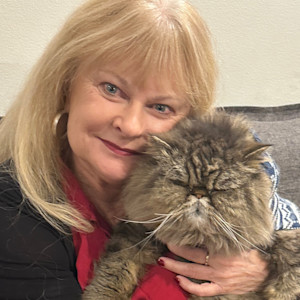
Dr. Shelby Neely, DVM
Dr. Shelby Neely is a freelance writer and veterinarian who graduated from The University of Pennsylvania and has practiced veterinary medicine for 30 years. She has found homes for hundreds of stray pets and has two cats as well as four grand-dogs and two grand-cats. In her spare time, Dr. Neely likes to be with her three children, their dogs and cats, and her own two cats. She also likes to see as many Broadway shows as possible.
Related articles
![Cat looks at their butt]() opens in a new tab
opens in a new tabWhy Is My Cat Bleeding From Their Anus?
It’s not a pretty problem to have, but it’s important to know how to treat this condition.
![Dog standing in the bathtub covered with a green towel after a bath.]() opens in a new tab
opens in a new tabHow to Express Dog Anal Glands Safely and Effectively at Home
Yeah, it’s super gross — but your pup will thank you.
- opens in a new tab
Why Do Cats Put Their Butt in Your Face?
Oh, hello.
![Woman feeding her puffy cat at the table.]() opens in a new tab
opens in a new tabWhat Human Foods Can Cats Eat?
We know they’re begging—but what’s safe to share?
![Woman Holding Her Black Cat.]() opens in a new tab
opens in a new tabWhen and How to Express Your Cat’s Anal Glands
Ick. It won’t be fun, but here’s how to get the job done.
![Two cute kittens are sitting near their litter box.]() opens in a new tab
opens in a new tabBest Odor-Control Cat Litter
A necessity, really.
